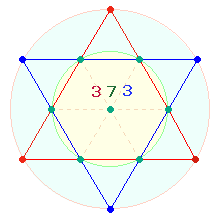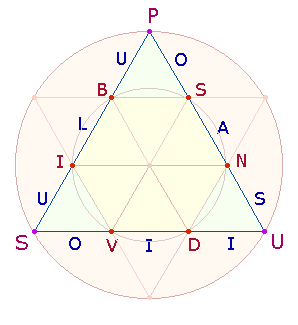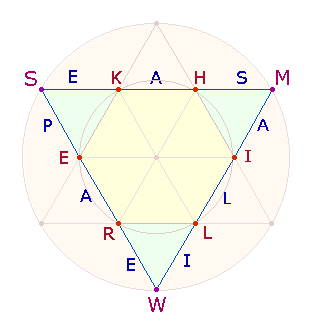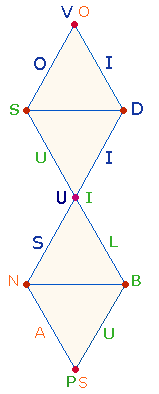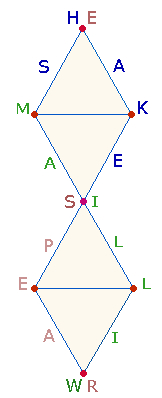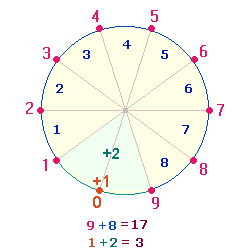Alphabets;
gematric calculator
Ovid's
and Shakespeare's epitaphs
Ovid's and Shakespeare's names in Tetractys and Double
Rhombus
I. Introduction
II. The Tetractys
III. The Double Rhombus
V. Including MARIA IESUS CHRISTUS
I. Introduction
1. We may assume that Shakespeare had
developed a long familiarity with Ovid before he eventually elaborated his
epitaph in gematric concinnity with Ovid's. He certainly appreciated Horace,
Vergil and other Roman poets no less, but his affection just inclined a bit
more towards Ovid. He chose him deliberately and representatively to build a
cultural bridge between Antiquity and Christianity.
2. Shakespeare may have felt a desire to
promote his poetic task and define his identity by comparing himself to a great
poet of the past. Perhaps he thought that divine providence predestined him to
continue Ovid's spirit in his own poetic work and to identify with him.
3. One striking parallel of their two names
is the number of 18 letters (while PUBLIUS VERGILIUS MARO consists of 20 and QUINTUS
HORATIUS FLACCUS of 22 letters).
Shakespeare knew the geometrical models for occupying 18
positions and may have tried them out. He could not manipulate any intended results,
as Ovid's names were fixed and Shakespeare had decided on a definite
orthography at some point of his life.
If Shakespeare found
meaningful results in combining his and Ovid's names, he may have accounted for
it as lucky coincidence or, perhaps, divine providence – we do not know.
4. The two geometrical models for 18 positions are the three sides of the tetractys
and the double
rhombus.
5. The numerical sums (NS) and
factoral sums (FS) of Ovid's and Shakepeare's names are:
|
|
NS |
FS |
sm |
|
PUBLIUS |
95 |
53 |
148 |
|
OVIDIUS |
94 |
51 |
145 |
|
NASO |
46 |
31 |
77 |
|
sm |
235 |
135 |
370 |
|
WILLIAM |
74 |
52 |
126 |
|
SHAKESPEARE |
103 |
71 |
174 |
|
sm |
177 |
123 |
300 |
|
total |
412 |
258 |
670 |
|
370:300 =
10*(37:30) |
|||
|
258 = 6*43 |
|||
The (countable) digits point
to 3+7 points
of the tetractys and 3
remaining points of the hexagram:
|
|
The factor 43 of the FS 258
can be understood as 4 points + 3 lines of one tetractys side. As the hexagram
contains 2 tetractyses, the 7 elements of one tetractys side has to be
multiplied by 6.
1.
The
frame of the tetractys consists of 9 points
and 9 lines:
|
|
|
The
points can be subdivided into 6 hexagonal
points and 3 corner points:
|
|
Ovid |
NS |
FS |
sm |
Shakesp. |
NS |
FS |
sm |
sm |
sm |
total |
|
6 p |
BIVDNS |
66 |
42 |
108 |
LIHKER |
60 |
52 |
112 |
126 |
94 |
220 |
|
3 p |
PSU |
53 |
25 |
78 |
WMS |
51 |
25 |
76 |
104 |
50 |
154 |
|
sm |
|
119 |
67 |
186 |
|
111 |
77 |
188 |
230 |
144 |
374 |
|
220:154 = 22*(10:7) = 22*17 = 11*34; 188 = 4*47 |
|||||||||||
The single sums on both sides are very similar. The numerical sums (NS) + factoral sums (FS)
of the 6p and 3p
letters of both sides are divisible by 22. The
two ratio numbers are relatable to 10 points of the tetractys and 7 of
the hexagon.
The NS+FS
112 and 76 are remarkable in that they
are identical with the NS and FS of CHRISTUS.
2.
The
values of the 9 lines are:
|
|
Ovid |
NS |
FS |
sm |
Shakesp. |
NS |
FS |
sm |
sm |
sm |
total |
|
9 li |
ULUOIISAO |
116 |
68 |
184 |
ILASAEPAE |
66 |
46 |
112 |
182 |
100 |
296 |
|
184:112 = 8*( |
|||||||||||
The single digits of the factors 34 and 37
can be associated with 3*4 points and 3*7 elements of the 3
tetractys sides. The NS+FS
186 and 184
of Ovid's points and lines are constituents of their sum, the number 370.
The NS of the 6
points and 9 lines are 126 and 182,
which are the NS+FS
and 4value sum of WILLIAM.
The additive result 308 = 11*28 is again divisible by 11.
112 is the FS of IESUS CHRISTUS (36+76).
1.
The
double rhombus, too, shows a frame pattern. If one starts at the bottom, the
points and lines can be counted and marked, either by numbers or letters, in an
eight-like loop until the starting point is reached again. As two double
rhombi, by folding the end triangles, can be composed to form
an octahedron, an additional 18th position can be marked:
|
|
|
The
points can be subdivided into 6 vertical and
4 horizontal points:
|
|
Ovid |
NS |
FS |
sm |
Shakesp. |
NS |
FS |
sm |
total |
|
6 p |
PIVVSO |
96 |
49 |
145 |
WIHSRE |
78 |
52 |
130 |
275 |
|
4 p |
BSDN |
37 |
27 |
64 |
LMKE |
38 |
30 |
68 |
132 |
|
sm |
|
133 |
76 |
209 |
|
116 |
82 |
198 |
407 |
|
209:198 = 11*( |
|||||||||
The neighbouring ratio numbers 19 and 18 are
identical with the elements of the tetractys: 10
points + 9 triangles and 18 lines.
Astonishingly, the factor 11 is again
contained in the subdivided points, but also in the NS+FS of either poet. And again the factors 34 and 37 can
be referred to the elements of the tetractys sides, but also to the double
rhombus, which consists of 21 elements, 4*3 "roof" elements (line, point, line)
of the frame and 3*3 mid elements: 3 vertical points and twice the combination of 2 triangles and 1
cross line.
3.
The
values of the 8 lines are:
|
|
Ovid |
NS |
FS |
sm |
Shakesp. |
NS |
FS |
sm |
SM |
SM |
total |
|
8 li |
ULUOIISA |
102 |
59 |
161 |
ILASAEPA |
61 |
41 |
102 |
163 |
100 |
263 |
The digits of 163
represent the 10 points of the tetractys, the prime
number 263 refers to
three octahedra consisting of 3*26 elements.
4.
Another
possibility of order may consist in the relation between the lower and the
upper rhombus inasmuch the last letters return to the first so that the upper
rhombus represents the centre and the lower the outer parts, comparable to two
concentric circles. However, there is the exception of the last letter that
belongs to the upper rhombus:
|
|
lower rh. |
NS |
FS |
sm |
upper rh. |
NS |
FS |
sm |
|
Ov. |
PUBLISNAS |
107 |
66 |
173 |
USOVIDIUO |
128 |
69 |
197 |
|
Sh. |
WILLIPEAR |
99 |
75 |
174 |
AMSHAKESE |
78 |
48 |
126 |
|
|
|
206 |
141 |
347 |
|
206 |
117 |
323 |
|
48:78 = 6*( |
||||||||
The results are remarkable in at least four respects:
First, the NS+FS of the lower rhombus is identical with the NS+FS of SHAKESPEARE, the NS+FS of the upper rhombus with the NS+FS of WILLIAM.
Second, the ratio 6*(8:13) refers to 6
double rhombi that are needed for three coordinate systems
to construct three octahedra. One double rhombus consists of
13 hexagonal and 8
extension elements.
Third, the NS of the
lower und upper rhombus are equally 206.
Fourth, the NS+FS 173 and 174 concern a central principle of the decimal
system: There are no more than 9 countable
basic numbers. Any measure needs delimiting by two points. So 9 points delimit 8 measures. The point for the first
of 10
measures is the uncountable 0. If the 10 measures are to be positioned on a straight line,
11 points are necessary, if they are arranged on a circle, the first and last
points converge. The two models can be represented by 17+4
and 17+3 and as 3-digit numbers:
|
|
|
The sum 174+173 = 347 appears a second
time in the FS 141 = 3*47. The number 347 is so important that it is the NS of the Christian Trinity PATER
FILIUS SANCTUS SPIRITUS.
The NS+FS
323 = 17*19 shows two aspects of the decimal systems: 9+8, as explained above, and 9 diametrical and 5+5
radial elements of the hexagram, as one model of uneven and even numbers.
1.
The NS+FS 670 of the names points to a double aspect of the
tetractys side: If the 9 points and 9 lines of three sides are divided by three, there
are 6
elements for one side. However, one side alone counts 7 elements. The letters for 3*7 and 3*6
elements are WS, the initials of WILLIAM SHAKESPEARE.
2.
In consequence, the three corner points have to
be counted once more and added to 670 so
that a new result emerges:
|
|
NS |
FS |
sm |
|
NS |
FS |
sm |
sm |
sm |
total |
|
36 letters |
412 |
258 |
670 |
6 letters |
104 |
50 |
154 |
516 |
308 |
824 |
|
412 = 4*103; 824 = 8*103 |
||||||||||
103 is the NS of SHAKESPEARE.
What has happened is a kind of exchange: 154 added to the FS 258 is equal to the NS 412, and
the NS 104 added to 412
is double the FS 258.
Written: June 2014
